As temperatures are slowly increasing again on Campus, nature is getting livelier. The increasing daylength and warmer weather can only mean one thing: the start of a new life cycle. Researchers at the University of Twente are studying the timing of the biological phases of animals and plants.
This area of study is called phenology, from the ancient Greek word “φαίνω” (pheno), meaning “to appear”. For many years, people have been recording the timing of biological events. A notable example is cherry blossom, an important Japanese symbol of life and death. In Kyoto, the record of cherry blossom spans over 1200 years.
Climate plays a crucial role in nature’s timing. For example, oak leaves appear earlier in Limburg than in Twente. Depending on factors like winter and spring temperature, buds of a tree will burst at varying times every year. This also implies that climate change affects the pace of nature.
Phenocams
To better understand the relationship between nature’s timing and climate factors, researchers worldwide observe phenology using various techniques. Due to the need for frequent observations, one simple method involves taking repeated pictures from a fixed position. Since 2019, two phenological cameras (PhenoCams) have been installed on the roofs of the Spiegel building and on the Horst tower. These automated webcams store a picture every half hour on a server. By focusing on specific areas (e.g. a group of trees), a measure of greenness is calculated and plotted through time.
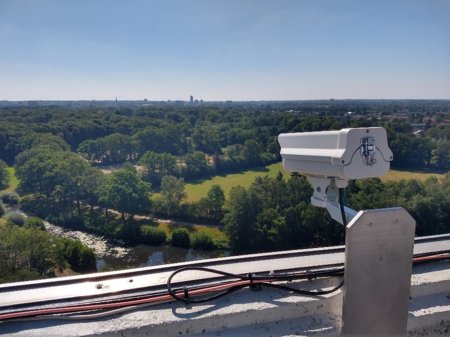
PhenoCam on the Horst Tower, looking towards Ledeboerpark. Photo: Anton Vrieling
Rather than visually determining whether we see leaves appearing on the picture, we can assess when trees attain a certain greenness threshold, and how this varies over the years. For example, due to the cold spring in 2021, PhenoCam data indicated that oaks behind the Spiegel reached their usual greenness levels around two weeks later than normal. These PhenoCams are part of a global network of cameras and their data can be openly viewed online.
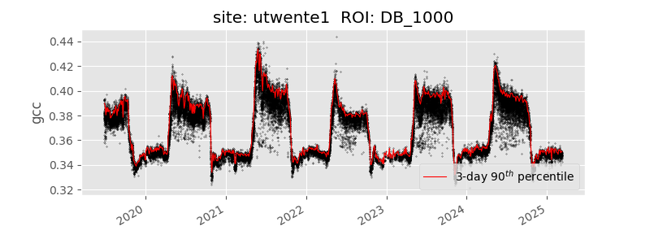
Greenness series from the PhenoCam camera for oak trees behind the Spiegel, clearly indicating the moments of leaf emergence and falling of leaves.
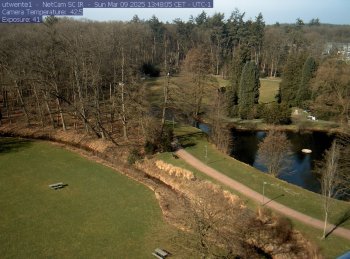
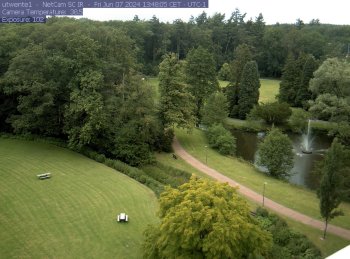
Image taken by the PhenoCam camera on the Spiegel. Left on 9 March 2025, Right on 7 June 2024.
For information, the spatial resolution of the collected imagery is too coarse to identify faces.
Further initiatives
UT has facilitated initiatives to enhance phenological monitoring with cheaper technology. Advances in edge computing have made it possible to use simpler equipment. This includes small affordable cameras that take multiple pictures throughout the day. Using the camera's built-in processing unit, these images are analyzed on the spot to calculate a greenness measure as an indicator of leaf growth and vegetation health. This approach reduces data transmission by sending only key greenness values instead of full images. Such low-cost monitoring and transmission can significantly increase the spatial density of timely phenological observations.
Rotating camera
To address the usual limited field of view of cameras, UT researchers have developed the VegTrack360, a prototype rotating camera platform that captures 360-degree views of the surrounding ecosystem for a more holistic view of nature’s development.
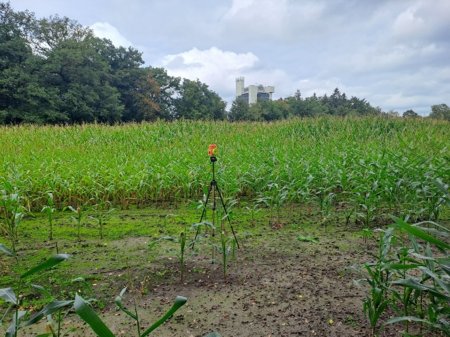
The VegTrack360 in action: a prototype 360° rotating camera. Photo: (Florian Ellsäßer)
While frequent observations by ground-based cameras provide highly detailed, localized information, they cannot provide a landscape perspective of vegetation phenology. Instead, satellite images allow measuring changes in plant greenness across much larger areas, but they require frequent observations to have sufficient ‘peeks’ through the clouds throughout the season. In the past, this was only possible with coarse spatial resolutions (e.g. pixel sizes of 250 by 250 m). Nowadays, recent technological advancements with satellites like Sentinel-2 or PlanetScope provided increasing options for frequent data acquisition at 10m resolution or below.
Resulting data from these sensors enable the monitoring of individual tree crowns or farmer fields over time, and facilitate the observation of planting and harvesting dates across large areas. However, it is crucial to verify that satellite observations accurately reflect changes on the ground. This leads us back to the visual observations and cameras; enhancing our understanding of phenology and climate controls requires views from different perspectives!
Long-term goals with this work include:
- Building long-time series of camera-based phenological observations to contribute to the global network. This should shed light on changes in leaf emergence and other biological events. Such changes, which are often climate-induced, are critical for biodiversity, given that animal populations (insects, birds) are strongly affected by temporal mismatches between food availability and their life events.
- Acquiring ground evidence for training satellite-based assessments of landscape-scale phenology. In this way, we want to learn for example how changes in climate and regulations affect farmers’ decisions with respect to planting and harvesting, with a view also to better understand the impacts of more extreme weather on crop productivity.
Biodiversity at UT
Strengthening biodiversity on our campus is one of our sustainability goals at the University of Twente. By improving monitoring, we gain knowledge about biodiversity on campus in general, which helps us decide on the best ways to support it. In 2024, we started the yearly Bioblitz, in which anyone can help monitor species via the app ObsIdentify. Several activities were organised to raise awareness of biodiversity (such as bird observation). A biodiversity council was established, where CFM (Campus & Facility Management) consult with biodiversity enthusiasts on how maintenance can contribute to an improved habitat for species. Furthermore, thanks to a Climate Centre grant, we are working on making data on green maintenance and biodiversity accessible for research and education.
Would you like to find out more about sustainability at UT? Please go to utwente.nl/sustainability.






